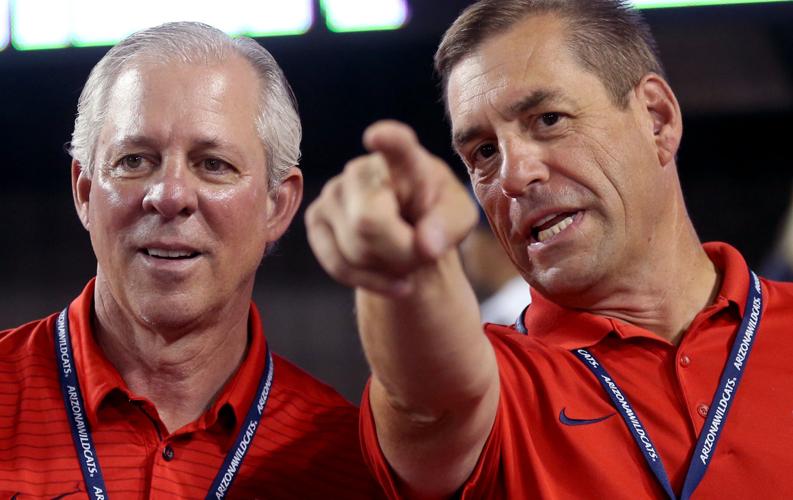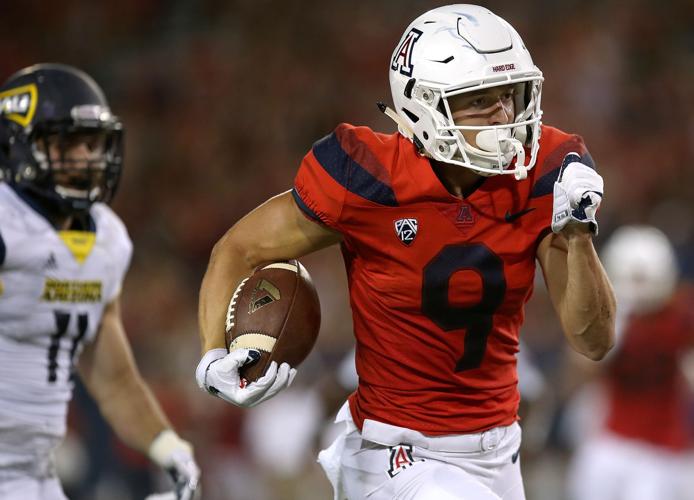This might be a first at Arizona Stadium: When Shun Brown returned a punt 66 yards for a touchdown Saturday night, new UA president Bobby Robbins stood at the edge of the end zone, raising both arms to signal touchdown.
Talk about your 12th man.
I’ll need to check the replay to be sure, but I believe Robbins was quicker to raise his arms than any of the eight referees.
Even though the Wildcats don’t appear to be a serious Pac-12 contender — even though attendance for Arizona’s 62-24 victory over NAU was 43,620, the smallest for a home opener since 2003 — this in many ways is a new age of UA football.
Rather than mingle all night with rich guys in the sky box suites, Robbins and new Arizona athletic director Dave Heeke spent much of the first quarter as part of the ZonaZoo. They dressed in khakis and golf shirts, signaling a new type of leadership for the athletic department.
Both attended (and spoke) at Friday’s rally at Main Gate Square, a not-so-subtle message that football at Arizona will be a priority and not just a diversion until October’s Red-Blue basketball game.
Their combined enthusiasm is Greg Byrne times two.
A few weeks ago, Robbins and Heeke went on a detailed inspection tour of Arizona Stadium, a structure that opened in 1929, and came to the same sobering reality that Byrne did a few years ago.
The old place is in need of a total makeover. The ancient infrastructure must be replaced.
Sooner rather than later, for untold of millions of dollars, Robbins and Heeke must decide whether to tear down the west side of the stadium and start over. But even before that, they probably must demolish the bottom half of the east grandstands — home of the ZonaZoo — and build a modern facility.
It’s a project of such scope that it’ll make recent construction of the $75 million Lowell-Stevens Football Facility seem like a guest bedroom.
Once USC spends an estimated $275 million to renovate the antiquated Los Angeles Coliseum by 2019 — roughly the same amount ASU spent to retrofit Sun Devil Stadium — Arizona Stadium will rank dead last, No. 12 of Pac-12 football stadiums.
Given their shared enthusiasm and interest in a winning football program, if Robbins and Heeke can’t build momentum and create a workable financing plan to rebuild Arizona Stadium, it might not get done for a decade or more.
And if they wait much longer, it might double in cost, to about $400 million or some other horrific figure.
Heeke was standing in the north end zone late in the first quarter when he was formally introduced to Saturday’s crowd at Arizona Stadium.
Initially, given Byrne’s high profile and ability to win friends and get things done, Heeke’s move from Central Michigan to Arizona was called a Tough Act to Follow.
But it’s more accurate to say it’s just a Tough Act.
About $15 million is needed to build an indoor workout facility, mostly for the football program. Another $10 million or so will be required to correct infrastructure issues at the Hillenbrand Aquatic Center. The tennis facility and Hillenbrand (softball) Stadium also need to be reworked.
Even McKale Center, which is still shining from a recent $30 million touch-up, needs more work.
This robust building plan will benefit from a new student fee, which someday could bring in about $4 million per year for the athletic department. The rest of the money will be paid over time via booster donations, revenue from the Pac-12 media rights package and year-to-year financing.
That’s how most of the Power 5 Conference schools not named Alabama and Ohio State do it in the 21st century.
Heeke doesn’t appear to be cowed by the financial challenges awaiting the Wildcats. “I’m eager to get at it,” he said Friday. “We need to get started right away.”
Compared to his predecessors, Heeke gets no break-in time.
When Jim Livengood arrived, his first day on the job was New Year’s Day, 1994. Arizona routed No. 10 Miami in a memorable 29-0 Fiesta Bowl the same day. Three months later the Wildcats played in the Final Four, went on to win the NCAA softball championship and finished No. 5 overall in athletic department rankings.
When Byrne replaced Livengood, the basketball transition from Lute Olson to Sean Miller was in place.
At Byrne’s first home football game, in 2010, Arizona drew 54,814 for a game against the Citadel, and a week later the Wildcats beat No. 9 Iowa and rose to No. 14 in the AP poll.
Times have changed. The life of Arizona’s AD is more challenging.
Heeke spent most of his first five months in Tucson alone. Grinding.
His wife, Liz, wasn’t able to make the move from Mount Pleasant, Michigan, until a few weeks ago. Now, moved into a home in the foothills, he knows the way to McKale Center; he also knows that a meager crowd of 43,620 on opening night at Arizona Stadium won’t do.
From 2005-15, in six home games against NAU, Arizona averaged 52,274 fans. Some things must change. Bobby Robbins and Dave Heeke are working on it.





